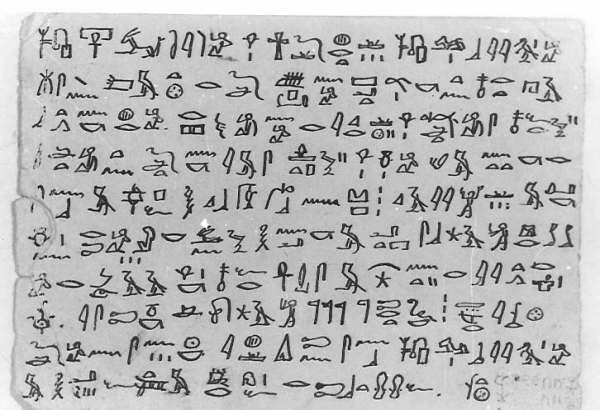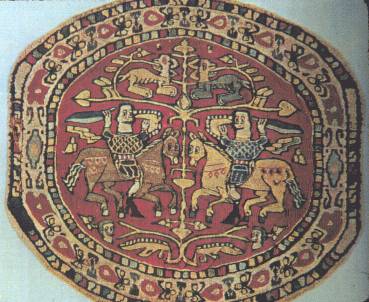|
Coptology
Coptology is the scientific study of the Coptic people. Origin The European interest in Coptology may have started as early as the 15th century AD. The term was used in 1976 when the First International Congress of Coptology was held in Cairo under the title "Colloquium on the Future of Coptic Studies" (11-17 December). This was followed by the establishment of the "International Association for Coptic Studies". International Association for Coptic Studies One of the founders of the Colloquium and the Association was Pahor Labib, director of the Coptic Museum in |
Stephen Emmel
Stephen Emmel is an American Coptologist and musician. Academic career Stephen Emmel was born in Rochester, NY, 27 June 1952, and earned his B.A. from Syracuse University in 1973 (department of religion). He began graduate study with James M. Robinson, who took Emmel with him to Cairo, Egypt, in 1974 as a research assistant in the international project to publish the Coptic Gnostic texts of the Nag Hammadi Codices. Emmel lived in Egypt 1974–77 in order to complete the conservation of the Nag Hammadi papyri in the Coptic Museum and to assist in the publication of both a facsimile edition of the Nag Hammadi Codices and an English-language edition and translation of the texts contained in them. During those years he traveled several times to Jerusalem to meet with the Egyptologist and linguist H. J. Polotsky in order to deepen his knowledge of Coptic grammar. In 1978 Emmel resumed his graduate study, now with Bentley Layton at Yale University, where in 1980 he discovered a ... [...More Info...] [...Related Items...] OR: [Wikipedia] [Google] [Baidu] |
Aziz Suryal Atiya
Aziz Suryal Atiya (, ; July 5, 1898 – September 24, 1988) was an Egyptian Coptologist who was a Coptic history, Coptic historian and scholar and an expert in Islamic and Crusades studies. Atiya was the founder of the Institute of Coptic Studies in Cairo in the 1950s, and was also the founder of the University of Utah Middle East Center, Middle East Center, University of Utah. His library, the Aziz Atiya Library for Middle East Studies at University of Utah, is considered the fifth largest of such collection in North America. While at the University of Utah, Professor Atiya rediscovered ten Joseph Smith papyri, lost papyri fragments related to the Mormon scripture, Book of Abraham, in the archives of the New York Metropolitan Museum of Art... Early life and education Atiya was born in Egypt on July 4, 1898, and was a Copts, Coptic Christian. He matriculated at the University of Liverpool, where he earned a bachelor's degree with first-class honors in medieval and moder ... [...More Info...] [...Related Items...] OR: [Wikipedia] [Google] [Baidu] |
Gorgi Sobhi
Gorgi Sobhi (1884–1964) was an Egyptian Professor of General Medicine, Professor of the History of Medicine and Professor of Egyptology. Life Sobhi was born in Mimon of Beni Suef, Egypt to a Coptic family. His mother died one week after he was born. Sobhi lived with his father, who was a manager in an arsenal factory. Dr. Harper, the British manager of Harmal Hospital in Cairo, fostered Sobhi and the family brought him up as a twin brother to their own son who was almost of the same age. Sobhi lived with the Harpers till the age of 9. Being brought up in an English family, he spoke fluent English. Sobhi was fluent in seven languages: English, French, Italian, Arabic, Greek, Latin and Coptic. He could also read hieroglyphics. He learned Italian while looking after the Italian prisoners of war during the First World War. Academic career in Medicine Sobhi achieved first place in the 11+ exam in Egypt. He obtained his primary school certificate from Al-Nasseriya School, th ... [...More Info...] [...Related Items...] OR: [Wikipedia] [Google] [Baidu] |
Pahor Labib
Pahor Labib (; Arabic: باهور لبيب ''Bahur Labib''; 19 September 1905 at Ain Shams, Cairo – 7 May 1994) was Director of the Coptic Museum, Cairo, Egypt, from 1951 to 1965 and one of the world leaders in Egyptology and Coptology. Early life and education Labib was born in 1905 in Cairo. His father was Cladius Labib, also an Egyptologist and Coptologist who was one of the first Egyptians to learn Hieroglyphics from the French Egyptologists in Egypt and who compiled a Coptic-Arabic dictionary. He grew up in Ain Shams, a suburb of Cairo, where his father had a house with a few acres of land (13 "feddans") that were used to cultivate fruits and vegetables. For preparatory school Labib went to the "Great Coptic School" and then to Khedivieh Secondary School, both in Cairo. After Labib received his "Bachaloria", he entered the Faculty of Law. However, the Faculty of Archeology had recently opened and he joined this as well. At the final year, exams for both studies clashe ... [...More Info...] [...Related Items...] OR: [Wikipedia] [Google] [Baidu] |
Institute Of Coptic Studies
The Institute of Coptic Studies is a postgraduate academic institute affiliated with the Coptic Orthodox Church of Alexandria. It was founded in Cairo, Egypt, in 1954, and its Grand President is Pope Tawadros II, the Pope of Alexandria and Patriarch of the See of St. Mark. History The idea of founding the Institute was initiated by historian and scholar Professor Aziz Suryal Atiya, who also founded the Middle East Center at the University of Utah. Several other prominent Coptic and Egyptology scholars participated in its foundation, including Professor Pahor Labib, who was Director of the Coptic Museum in Old Cairo from 1951 to 1965. Since its establishment, the Institute has played a key role in developing and preserving Coptic heritage, and has been involved in both academic and cultural efforts related to Coptic theology, history, art, architecture, music, language, archaeology, literature, and African studies. It collaborates with local and international academic institu ... [...More Info...] [...Related Items...] OR: [Wikipedia] [Google] [Baidu] |
Christian Cannuyer
Christian Cannuyer (born 17 December 1957) is a Belgian historian of religion, professor at the Lille Catholic University, a specialist in Coptic studies and a genealogist. Career Christian Cannuyer teaches ancient Near Eastern religions, Christian church history, and Coptic language at the Theological Faculty of Lille Catholic University. He has published a number of books, including a volume on the Copts – (1990, collection ""), which won the 1991 Eugène Goblet d'Alviella Prize in the History of Religions of the Royal Academy of Belgium; a lavishly illustrated pocket book for the collection "Découvertes Gallimard" – (2000), which is only available in English and French. He has also authored many articles, such as , , et cetera. Cannuyer is editor of the "" collection at Brepols, published in collaboration with the Centre Informatique et Bible of the Maredsous Abbey. He is the president of the Société Royale Belge d'Études Orientales since 1994 and member of ... [...More Info...] [...Related Items...] OR: [Wikipedia] [Google] [Baidu] |
Göttinger Miszellen
''Göttinger Miszellen'' (often abbreviated as GM) is a scientific journal published by the Seminar für Ägyptologie und Koptologie of the University of Göttingen,Germany which contains short scholarly articles on Egyptological, Coptological, and other related subjects. Founded in 1972, its aim is to publish information about new discoveries and theories as quickly and efficiently as possible, and to be a forum for scholarly discussions on Egyptology. In line with this philosophy, GM is published at least four times a year, and contributors (who may submit articles in German, English or French) are required to submit camera-ready copy, as articles are reproduced photographically rather than being re-typed or loaded from diskette. Copy is not edited at all by the publishers and is the verbatim work of each author. Each issue is approximately 112 pages in length and costs 4.50 euro The euro (currency symbol, symbol: euro sign, €; ISO 4217, currency code: EUR) is the ... [...More Info...] [...Related Items...] OR: [Wikipedia] [Google] [Baidu] |
Egyptology
Egyptology (from ''Egypt'' and Ancient Greek, Greek , ''wiktionary:-logia, -logia''; ) is the scientific study of ancient Egypt. The topics studied include ancient Egyptian History of Egypt, history, Egyptian language, language, Ancient Egyptian literature, literature, Ancient Egyptian religion, religion, Ancient Egyptian architecture, architecture and Art of ancient Egypt, art from the 5th millennium BC until the end of its native religious practices in the 4th century AD. History First explorers The earliest explorers of ancient Egypt were the ancient Egyptians themselves. Inspired by a dream he had, Thutmose IV led an excavation of the Great Sphinx of Giza and inscribed a description of the dream on the Dream Stele. Less than two centuries later, Prince Khaemweset, fourth son of Ramesses II, would gain fame for identifying and restoring historic buildings, tombs and temples, including pyramids; and has subsequently been described as the first Egyptologist. Classical Antiqu ... [...More Info...] [...Related Items...] OR: [Wikipedia] [Google] [Baidu] |
Coptic Museum
The Coptic Museum is a museum in Coptic Cairo, Egypt with the largest collection of Coptic Christian artifacts in the world. It was founded by Marcus Simaika in 1908 to house Coptic antiquities. The museum traces the history of Egypt from its beginnings to the present day. It was erected on 8,000 square meter land offered by the Coptic Orthodox Church, under the guardianship of Pope Cyril V. The Coptic museum houses the world's most important examples of Coptic art. History In 1908, after receiving approval and a number of silver antiquities from Patriarch Cyril V and raising funds by public subscription, Marcus Simaika Pasha built the Coptic Museum and inaugurated it on 14 March 1910. The Coptic community was generous in their support of the museum, donating many vestments, frescoes, and icons. In 1931 the Coptic Museum became a state museum, under the jurisdiction of the Department of Antiquities, and in 1939 the collection of Christian antiquities in the Egyptian Museum wa ... [...More Info...] [...Related Items...] OR: [Wikipedia] [Google] [Baidu] |
Coptic Art
Coptic art is the Christianity, Christian art of the Byzantine empire, Byzantine-Roman Egypt, Greco-Roman Egypt and of Coptic Orthodox Church, Coptic Christian Churches. Coptic art is best known for its wall-paintings, textiles, illuminated manuscripts, and metalwork, much of which survives in monasteries and churches. The artwork is often functional, as little distinction was drawn between artistry and craftsmanship, and includes tunics and tombstones as well as portraits of saints. The Coptic Museum in Coptic Cairo houses some of the world's most important examples of Coptic art. Origins Coptic art displays a mix of Egyptian and Hellenistic art, Hellenistic influences. Subjects and symbols were taken from both Greek mythology, Greek and Egyptian mythology, sometimes altered to fit Christianity, Christian beliefs. Persia and Syria also influenced Coptic and Hellenistic art, though to a lesser extent, leaving images such as the peacock and the griffin. Icon painting Coptic ... [...More Info...] [...Related Items...] OR: [Wikipedia] [Google] [Baidu] |
Coptic Literature
Coptic literature is the body of writings in the Coptic language of Egypt, the last stage of the indigenous Egyptian language. It is written in the Coptic alphabet. The study of the Coptic language and literature is called Coptology. Definition Since the term "Coptic" can have, besides a linguistic sense, an ethnic sense (referring to Copts) and a religious sense (Coptic Christianity), there is the propensity for ambiguity in the term "Coptic literature". Coptic literature is usually defined as that in the Coptic language. It is not usually limited to original compositions, but includes also translations into Coptic (mainly from Ancient Greek language, Greek). It also includes texts believed to have been composed in Coptic, but which are preserved only in translation (mainly in Arabic and Ethiopic). In a broader sense, "Coptic" may include Greek literature produced in Egypt that circulated in the Coptic community. The literature that the Copts wrote in Arabic is generally treated ... [...More Info...] [...Related Items...] OR: [Wikipedia] [Google] [Baidu] |

